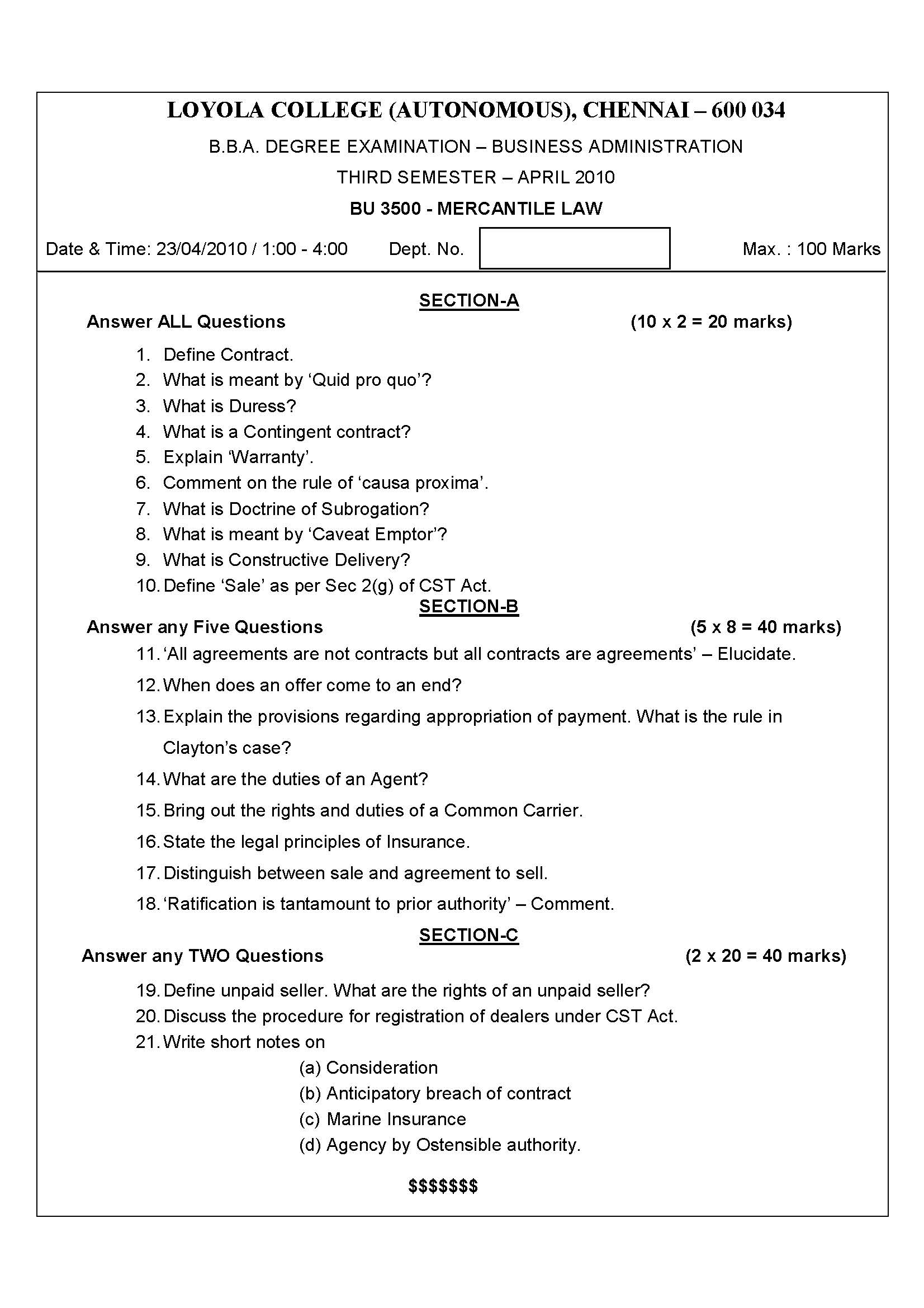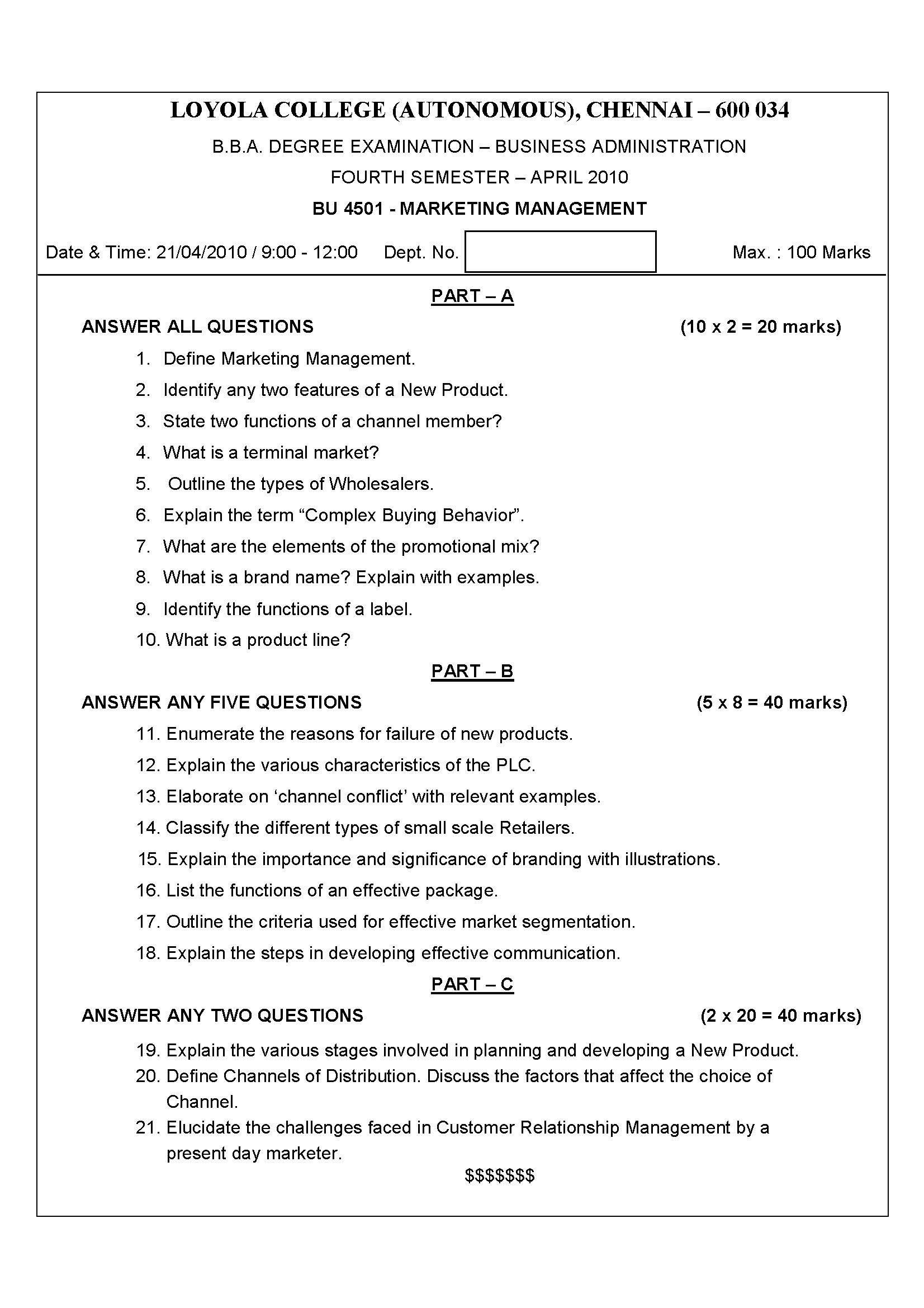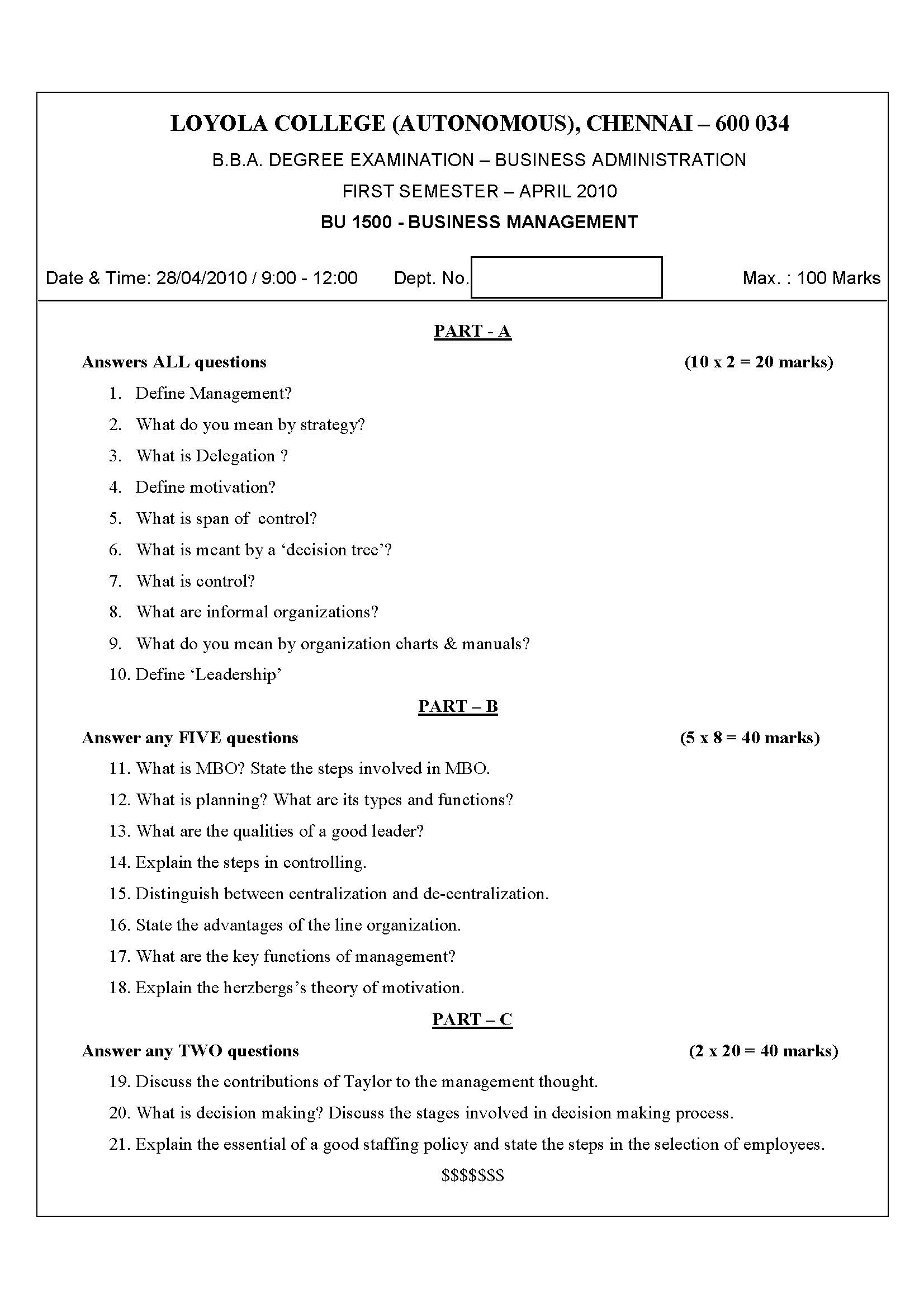BBA Business Administration Question Paper 2010
Loyola College B.B.A. Business Administration Nov 2010 Human Resource Management Question Paper PDF Download
LOYOLA COLLEGE (AUTONOMOUS), CHENNAI – 600 034
B.B.A. DEGREE EXAMINATION – BUSINESS ADMINISTRATION
FIFTH SEMESTER – NOVEMBER 2010
BU 5505/BU 5502 – HUMAN RESOURCE MANAGEMENT
Date : 09-11-10 Dept. No. Max. : 100 Marks
Time : 9:00 – 12:00
SECTION – A
Answer ALL Questions (10 x 2 = 20 Marks)
- State any two objectives of HRM?
- What do you understand by job specification?
- Why induction of employees is important?
- Define Human Resource Planning.
- Identify any two qualities of a HR manager.
- Write a short note on vestibule training.
- What is job description?
- Differentiate between recruitment and selection.
- What do you understand by negative discipline?
- Describe a patterned interview.
SECTION – B
Answer any FIVE questions (5 x 8 = 40 Marks)
- Critically examine Maslow’s theory of motivation.
- 12. Why do you think job analysis is essential?
- Discuss the three stages of interview procedure.
- Broadly classify the types of tests.
- Explain any three methods of executive development.
- Discuss any three methods of performance appraisal.
- How will you evaluate the effectiveness of a training program?
- State the essentials of a sound grievance procedure.
SECTION – C
Answer any TWO Questions: (2 x 20 = 40 Marks)
- Discuss the Managerial and Operative functions of HRM.
- Explain the stages in Human Resource Planning.
- Determine the various sources of recruitment.
Loyola College B.B.A. Business Administration Nov 2010 Cost Accounting Question Paper PDF Download
LOYOLA COLLEGE (AUTONOMOUS), CHENNAI – 600 034
B.B.A. DEGREE EXAMINATION – BUSINESS ADMINISTRATION
FIFTH SEMESTER – NOVEMBER 2010
BU 5504/BU 5501 – COST ACCOUNTING
Date : 03-11-10 Dept. No. Max. : 100 Marks
Time : 9:00 – 12:00
PART – A
Answer ALL questions: (10×2=20 marks)
Explain the following:
- Equivalent units
- Opportunity cost
- Abnormal loss and Abnormal gain
- Work certified and Retention money
- State the basis for apportioning the following expenses to different departments:
- Power
- Canteen expenses
- C) Stock insurance
- d) Crèche expenses
- The works cost of a product is Rs.8000. factory overheads are Rs.1000, which is 50% of wages. Calculate the value of direct material used.
- Standard time 10 hours, time taken 6 hours, time rate Rs.5 per hour. Calculate the earnings of a worker under Halsey and Rowan plan.
- Calculate economic order quantity and the number of orders to be placed in a year from the following data:
Annual consumption 10000 kg; ordering cost per order Rs.50; cost per kg Rs.2; storage expenses 8% per annum on inventory.
- From the following data compute the cost per unit assuming a batch of 1000 units are produced:
Material – Re 1 per unit. Each unit takes 10 minutes to produce.
Machine operator is paid Rs.12 per hour. The machine hour rate is Rs.1.50.
The setting up time for the machine is 1 hour.
- Profit as per financial accounts Rs.2000.
Works overheads under recovered in cost – Rs.12000
Transfer fees in financial accounts – Rs.1000
Calculate the profit as per Cost Accounts.
PART – B
Answer any FIVE questions: (5×8=40 marks)
- What are the benefits obtained by installing a Costing system? What are the practical difficulties in installing the system?
- What is labour turnover? What are its causes and costs?
- X Ltd undertook a contract for Rs.6,50,000 on 1st April 2009. The following details relate to the contract for the year ending 31st December 2009.
Materials issued Rs.1,80,000
Wages paid Rs.87,000
Other expenses Rs.38,750
Plant issued to contract Rs.32,000
Total establishment expenses amounted to Rs.40000, out of which 25% is chargeable to the contract. Out of the materials issued, materials costing Rs.4,000 were sold for Rs.5,000. Plant costing Rs.2,000 was damaged on 1st October 2009 and was sold as scrap for Rs.300. Plant is to be depreciated at 10% per annum.
Material at site on 31st December 2009 was Rs.17,500.
Cash received from contractee Rs.3,06,000 which is 90% of work certified.
Work uncertified on 31st December 2009 Rs.30,000.
Prepare the contract account.
- A transport company runs a bus between two towns which are 100 kms apart. The seating capacity of the bus is 40 passengers. It carries full capacity on the upward journey but only 75% of the capacity on the return journey. Bus runs for 30 days in a month and makes one round trip every day. The following details relate to the month of April 2010:
Wages of driver and conductor Rs.9,000
Diesel and oil Rs.18,000
Repairs and maintenance Rs. 8,000
Garage rent Rs.2,000
Taxes and insurance Rs.24,000 per annum
The bus costs Rs.4,00,000 and has a life of 10 years with an estimated scrap value of Rs.40,000.
Calculate the cost per passenger km. Also calculate the fare per passenger kilometer, if the company wants a profit of 50% on the fare.
- A factory is engaged in the production of a chemical X and in the course of its manufacture, a by-product Y is produced, which after a separate process has a commercial value. For the month of January 2009, the following are the summarized cost data:
Joint expenses Separate expenses
X Y
Rs. Rs. Rs.
Materials 29,200 8,360 1,780
Labour 14,700 5,680 2,042
Overheads 3,450 1,500 544
The output for the month was 150 tonnes of X and 50 tonnes of Y and the selling price of X was Rs.500 per tone and that of Y Rs.290 per tone.
Assuming that the profit of Y is estimated at 25% of the selling price, prepare a statement showing the profit made on Product X.
- The following details relate to the year 2004:
Material Rs.100000
Labor Rs.50000
Direct expenses Rs.20000
Factory overheads Rs.25000
Administration overheads Rs.39000
Selling overheads Rs.19500
Sales Rs.278850
During the year 2005 the company received a work order which requires, Material Rs.8000, Labor Rs.4000 and Direct expenses Rs.1500. What price should the company quote for this order, if it wants the same rate of profit on selling price as was realized in the year 2004? Assume factory overheads are recovered as a percentage of direct labor and administration and selling overheads as a percentage of works cost.
- From the following information, calculate a composite machine rate, for a machine whose scrap value is Rs.20,000.
- Cost of machine 3,80,000
- Installation charges 40,000
- Working life 10 years
- Working hours 8000 per year
- Repair charges 40% of depreciation
- Power 10 units per hour at 40 paisa per unit.
- Lubricating oil 4 per day of 8 hours
- Consumable stores 10 per day of 8 hours
- Machine operator’s wages 20 per day
- In a factory, there are two Production depts., A and B, and two Service depts., X and Y. the overhead expense of these four depts. are as follows:
A – Rs.6,780; B – Rs.6,020; X – Rs.1,200 and Y Rs.1,000
The expenses of the Service Dept are to be divided between the other departments on the following percentage basis:
Dept. X Dept A 50% Dept B 30% Dept Y 20%
Dept. Y Dept A 50% Dept B 50% –
- Prepare a statement showing the distribution of the Service dept expenses to the Production dept.
- Dept A absorbs overheads at a rate per labor hour and Dept B at the rate per machine hour. The estimated labor hours and machine hours in the respective depts. are 2000 hours and 1000 hours respectively.
Calculate the overhead recovery rates for the two departments.
- Calculate the price to be quoted for a job that requires Rs.500 in material, Rs.200 in wages and uses 6 Labor hours in Dept A and 4 machine hours in Dept B.
The company wants a profit of 50% on selling price.
PART – C
Answer ANY TWO questions (2×20=40 marks)
- The following details are supplied by an oil distributing company for the month of October 2009.
Stock on 1st October 2009 – 2000 litres at Rs.5 per litre
Receipts for the month:
7th 1000 litres at Rs.6 per lt.
15th 2000 litres at Rs.6.50 per lt
Issues during the month:
10th 2500 litres
31st 2200 litres
On 31st October 2009 a shortage of 100 litres was noticed.
Prepare Stores Ledger under:
- FIFO method
- Weighted Average method.
- From the following data calculate: (a) Equivalent production, (b) Cost per unit of equivalent production; and
(c) Statement of apportionment of cost , (d) Prepare the Process A account.
No. of units introduced in the process A 4,000 units
No. of units completed and transferred in Process B 3,200 units.
No. of units in process at the end of the period 620 units.
Stage of completion:
Material 80%
Labour 70%
Overheads 70%
Normal process loss at the end of the process 200 units
Value of scrap Re.1 per unit
Value of raw materials Rs.11,228
Wages Rs.7,228
Overheads Rs.3,614
- The following figures relate to R Ltd. for the year ending 31st March 2007:
Financial A/cs (Rs.) Cost A/cs (Rs.)
Opening Stock:
Raw material 8000 5000
Work in progress 7000 8500
Finished stock 5000 4500
Closing Stock:
Raw material 3000 4500
Work in progress 3000 4700
Finished stock 6900 6200
Purchases 40000 40000
Direct wages 20000 20000
Factory overheads 18000 21000
Administration overheads 3000 2300
Selling overheads 4000 4500
Loss on sale of assets 1000 –
Interest and dividend received 1600 –
Sales during the year was Rs.1,20,000.
Calculate the profit in Financial A/cs and Cost A/cs and prepare a statement reconciling the two profits.
Loyola College B.B.A. Business Administration Nov 2010 Company Law & Sec. Practice Question Paper PDF Download
LOYOLA COLLEGE (AUTONOMOUS), CHENNAI – 600 034
B.B.A. DEGREE EXAMINATION – BUSINESS ADMINISTRATION
THIRD SEMESTER – NOVEMBER 2010
BU 3501 – COMPANY LAW & SEC. PRACTICE
Date : 02-11-10 Dept. No. Max. : 100 Marks
Time : 9:00 – 12:00
SECTION – A
ANSWER ALL THE QUESTIONS. (10 x 2=20)
- Explain the concept of ‘limited liability’.
- What is minimum subscription?
- Who can become a company secretary?
- Mention the purposes of Memorandum of Association.
- Define prospectus.
- List the statutory book to be maintained by a company.
- Define dividend.
- What is Articles of Association?
- When is a notice given?
- Give the meaning of ‘minutes’.
SECTION – B
ANSWER ANY FIVE QUESTIONS. (5 x 8=40)
- Distinguish between a public and a private company.
- Enumerate the differences between memorandum and articles of association.
- What are various duties of a company secretary under Companies Act?
- Discuss the secretarial duties relating to payment of dividend.
- Draft an ordinary and a special resolution.
- Discuss the important provisions relating to foreign companies.
- Who is a Promoter? Explain the main functions of a Promoter.
- Explain the characteristics of a joint stock company.
SECTION – C
ANSWER ANY TWO QUESTIONS. (2 x 20=40)
- Discuss the privileges and exemptions available to all Private Companies.
- Write a note on (a) Doctrine of ultra vires. (b) General principles of drafting.
- Explain the contents of memorandum of association and the procedure for alteration.











